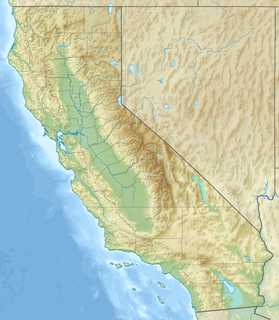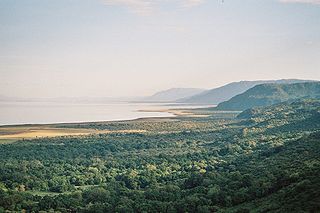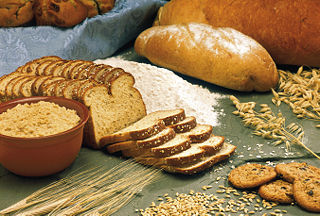
The Golden Gate Biosphere is a biosphere reserve in Northern California. It was created by UNESCO in 1988 and encompasses 13 protected areas in the San Francisco Bay Area. It extends through the central California coastal region from the Bodega Marine Reserve in the north to Jasper Ridge in the south and includes the Farallon Islands, Angel Island, and Alcatraz within the San Francisco Bay. The biosphere reserve is situated on both sides of the San Andreas Fault. Each side has a completely different type of bedrock, and the western side of the rift is moving northward. It encompasses a diverse range of marine, coastal, and upland habitats of the California chaparral and woodlands and Northern California coastal forests ecoregions, including mixed evergreen forests, Coast Redwood forests, Douglas-fir forests, Bishop pine forests, oak forests, woodlands and savannas, northern coastal scrub, chaparral, coastal dune, coastal strand, tidepools, kelp forests, coastal grasslands, and marshes. The associated fauna is also rich with cougars, Tule elk, California sea lions, elephant seals, and many shorebirds.

The Long Point Biosphere Reserve is located in southern Canada on the shores of Lake Erie in Norfolk County. The area encompasses a rich mosaic of ecological systems associated with erosion deposit sand spit formations around the Laurentian Great Lakes, as well as some of the largest remaining forest tracts in "Carolinian Canada". The variety of habitats supports a rich flora and fauna, including a waterfowl staging area and a migration stopover area for land birds of continental importance. Long Point Biosphere Reserve has been recognized as a Ramsar site and as a globally significant Important Bird Area by Bird Life International. Established in 1960, the bird observatory is the oldest, continuously operated, in North America.

The Angelo Coast Range Reserve is located in the Northern Outer California Coast Ranges, in Mendocino County, Northern California. The 7,660-acre reserve includes a section of the Eel River.

The Waddensea of Hamburg between Elbe and Weser is a German Biosphere reserve. It was added in 1992 by the UNESCO in their "man and biosphere" (MAB).
The Miramare Biosphere Reserve and Marine Reserve is situated about 7 kilometres (4.3 mi) km from the city of Trieste on the Gulf of Trieste close to the Slovenian border. It represents a rocky promontory of karst with coastal cliffs and beaches. Marine habitats of special interest from a conservation perspective are the tidal zone which harbours many endemic species, such as Fucus virsoides, and undisturbed cliffs with a diverse benthic fauna. The aim of the biosphere reserve is to maintain biological diversity in the marine environment surrounding Trieste through scientific research and monitoring activities. Environmental education designed for students and the public is also a major activity in the area.

Situated in south-west Scotland, the Silver Flowe-Merrick Kells biosphere reserve is composed of two separate sites.
The Iroise National Nature Reserve is a French Biosphere reserve consisting of three inhabited islands, as well as the Molène archipelago which consists of around twenty smaller islands, plus the waters between the islands. All the major ecosystems of the Atlantic biogeographical region are represented: the marine environment, beaches, cliffs with Atlantic coastal vegetation, heathlands and grasslands.

Konza Prairie biosphere reserve was a UNESCO Biosphere Reserve encompassing the Konza Prairie Biological Station in north-eastern Kansas. It was designated a biosphere reserve in 1978 and was one of 17 reserves in the United States withdrawn from the programme in June 2017.

The Alakol Biosphere Reserve is a UNESCO Biosphere Reserve located in Kazakhstan, within the desert zone of Eurasia in the central part of the Alakol inter-mountain depression. The 193,089 hectares (745.52 sq mi) reserve lies on the Central Asian–Indian bird migration route. The wetlands of the reserve are of global significance as a habitat and as a nesting site for water birds.

The Island of Príncipe Biosphere Reserve is a UNESCO Biosphere Reserve in São Tomé and Príncipe. It encompasses the entire emerged area of the island of Príncipe, its islets Bom Bom, Boné do Jóquei, Mosteiros, and Pedra da Galé, and the Tinhosas islands as well as surrounding marine habitats. The reserve is located in the Gulf of Guinea off the west coast of Africa, and is managed by the regional government of Príncipe.

Alto Golfo de California Biosphere Reserve is a UNESCO Biosphere Reserve located in the state of Sonora in extreme northwestern Mexico. The 1,652,110 hectares (6,378.8 sq mi) reserve comprises the El Pinacate y Gran Desierto reserve and the Bahia Adair on the Gulf of California border. Geological volcanic formations with craters, dunes, oasis and beaches, and the diversity of plant associations determine its special landscape. The reserve was established in 1993 by the President of Mexico as Reserva de la Biosfera del Alto Golfo de California y Delta del Río Colorado and extended in 1995.

The Redberry Lake Biosphere Reserve is a UNESCO Biosphere Reserve covering 112,200 hectares (433 sq mi) in the province of Saskatchewan, southwest Canada. The regional landscape is composed of rolling prairie dotted with seasonal ponds and marshes along with aspen/shrub groves. The core area is Redberry Lake, a saline lake with several islands. There are small patches of natural mixed prairie which are very rare in this highly grazed and cultivated part of the prairies.

The Niagara Escarpment Biosphere Reserve is a UNESCO Biosphere Reserve located in Ontario, Canada. The reserve stretches 725 kilometres (450 mi) along the Niagara Escarpment from Lake Ontario to the tip of the Bruce Peninsula. The Escarpment corridor crosses two major biomes: needle leaf forests in the north and temperate broadleaf forest in the south.

The Brighton and Lewes Downs Biosphere Reserve is a UNESCO Biosphere Reserve located in Sussex on the southeast coast of England near the city of Brighton and Hove. Forming a central unit of the hills of the South Downs National Park, it is centred on the Brighton chalk block that lies between the River Adur in the west and the River Ouse in the east. Chalk downland makes up the principal terrestrial landscape of the area, bounded at each end by the two river valleys. The coastline is dominated by impressive chalk cliffs in the east and urbanized plains in the west, running to the estuary of the River Adur at Shoreham-by-Sea. The area is nationally and internationally renowned for its arts and culture, distinctive settlements, independent mindset and its links to the surrounding iconic English landscape of downland, white chalk cliffs and beaches.
The landscape of the Manicouagan – Uapishka Biosphere Reserve is dominated by the Saint Lawrence River to the south and the Manicouagan reservoir to the north, forming a circle visible from great distances, even from space. They are linked by a web of rivers, which flow through vast woodlands.

La Encrucijada Biosphere Reserve is a UNESCO Biosphere Reserve situated in the Pacific Coastal Lowlands physiographic region of Mexico. It covers 144,848 hectares (559.26 sq mi) stretching over six municipalities in the Costa de Chiapas. It is composed of two large coastal lagoon systems that correspond to two core areas, and a wide variety of natural ecosystems including mangroves, zapotonales, tule swamps and marshes, as well as patches of tropical seasonal forest, coastal dunes and palm trees.

The Lake Manyara Biosphere Reserve is a UNESCO Biosphere Reserve in the depression of the East African Rift Valley in the Lake Manyara Basin in northern Tanzania. The reserve is managed by Tanzanian Lake Manyara National Park.

The Sierra de Manantlán Biosphere Reserve is a UNESCO Biosphere Reserve in the states of Colima and Jalisco, Mexico. The 139,577 hectares (538.91 sq mi) reserve is located in the transition of the Nearctic and Neotropical realms and encompasses parts of the Sierra Madre del Sur, with a wide range of altitudes, climates and soils. The effects of tectonic and volcanic activities and erosion are notable within the reserve.

The Roztochya Biosphere Reserve is a UNESCO Biosphere Reserve in Ukraine. Roztochya, Ukraine, has a total size of 74,800 hectares (289 sq mi) with its main economic activities including agriculture, stock-breeding and fish farming. The site is located on the north-western edge of the Podillya Upland, 20 kilometres (12 mi) from the city of Lviv, with an area of 30,000 hectares (120 sq mi). The site attracts visitors to its sanatoria and there are plans for developing business and tourism. There is on-going and planned cooperation with Poland in the Roztochya region.

The Everglades & Dry Tortugas Biosphere Reserve is a UNESCO Biosphere Reserve in Florida and the Gulf of Mexico. The 636,411 hectares (2,457.20 sq mi) reserve encompasses Everglades National Park and Dry Tortugas National Park, including historic Fort Jefferson and the seven Dry Tortugas islands.






















